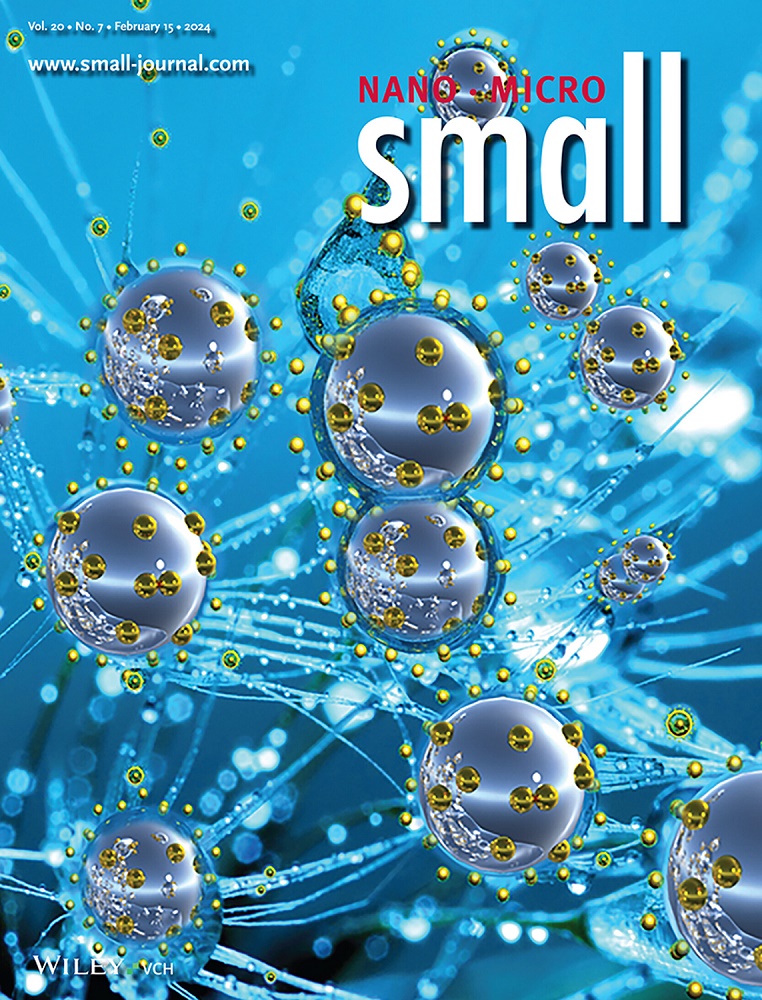Size and Chemical Environment Control Nanopore Geometry in 2D MoS2: From Irregular to Triangular Defects.
IF 13
2区 材料科学
Q1 CHEMISTRY, MULTIDISCIPLINARY
引用次数: 0
Abstract
Defects in 2D transition metal dichalcogenides (TMDs), such as molybdenum disulfide (MoS2), can modulate their optoelectronic and membrane properties. Increased structural complexity and a quasi-2D nature complicate the study of extended defects in MoS2. To address this knowledge gap, coordination-dependent atomic fingerprints are advanced for undercoordinated atoms in TMDs, enabling the cataloging of nanopore isomers in MoS2. Combining the introduced fingerprints with extensive density functional theory calculations of etching energies, stochastic kinetic Monte Carlo simulations of defect formation, and chemical graph theory for distinguishing nanopore shapes, predicts the most probable nanopores in MoS2. A range of size-dependent topologies are revealed from elongated to perfectly triangular, where smaller defects are irregular, while larger ones are more symmetric, exhibiting qualitative agreement with experiments. Moving toward a sulfur-rich chemical environment slows down the growth of larger pores and makes them perfectly triangular, providing an experimental route to control nanopore synthesis. The size-dependent structural order in MoS2 nanopores elucidated here will enable precise control over the defect shape and size distribution in the material for various application areas, including seawater desalination, gas separations, DNA sequencing, and optoelectronic devices.尺寸和化学环境控制二维二硫化钼纳米孔几何结构:从不规则缺陷到三角形缺陷。
二维过渡金属二硫化物(TMDs)中的缺陷,如二硫化钼(MoS2),可以调节其光电和膜性能。增加的结构复杂性和准二维性质使二硫化钼扩展缺陷的研究复杂化。为了解决这一知识缺口,tmd中欠配位原子的配位依赖原子指纹图谱被提出,使二硫化钼的纳米孔异构体得以编目。结合引入的指纹图谱、蚀刻能量的密度泛函数理论计算、缺陷形成的随机动力学蒙特卡罗模拟和区分纳米孔形状的化学图理论,预测了二硫化钼中最可能的纳米孔。揭示了一系列尺寸相关的拓扑结构,从细长到完全三角形,其中较小的缺陷是不规则的,而较大的缺陷更对称,与实验表现出定性一致。向富含硫的化学环境移动会减缓大孔的生长,使它们呈完美的三角形,为控制纳米孔的合成提供了一条实验途径。本文阐明的二硫化钼纳米孔的尺寸依赖结构顺序将能够精确控制材料中缺陷的形状和尺寸分布,用于各种应用领域,包括海水淡化、气体分离、DNA测序和光电器件。
本文章由计算机程序翻译,如有差异,请以英文原文为准。
求助全文
约1分钟内获得全文
求助全文
来源期刊

Small
工程技术-材料科学:综合
CiteScore
17.70
自引率
3.80%
发文量
1830
审稿时长
2.1 months
期刊介绍:
Small serves as an exceptional platform for both experimental and theoretical studies in fundamental and applied interdisciplinary research at the nano- and microscale. The journal offers a compelling mix of peer-reviewed Research Articles, Reviews, Perspectives, and Comments.
With a remarkable 2022 Journal Impact Factor of 13.3 (Journal Citation Reports from Clarivate Analytics, 2023), Small remains among the top multidisciplinary journals, covering a wide range of topics at the interface of materials science, chemistry, physics, engineering, medicine, and biology.
Small's readership includes biochemists, biologists, biomedical scientists, chemists, engineers, information technologists, materials scientists, physicists, and theoreticians alike.
 求助内容:
求助内容: 应助结果提醒方式:
应助结果提醒方式:


